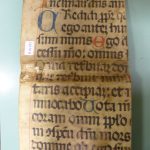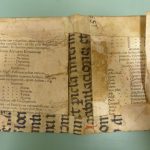The fragment’s history goes back to the turn of the 15th and 16th centuries. About this time an ornate psalter was made in the scriptorium of the royal chancellery in Buda for a today unknown Franciscan community. The illuminators of the workshop richly decorated the initials starting each liturgical day, as is fair to masters in the king’s service. By this, they made an easily identifiable mark in the manuscript. (For other surviving manuscripts of the workshop see Árpád Mikó, „Fáncsi Imre armálisa (1511) és két Budán illuminált, kottás díszkódex” [The armalis of Imre Fáncsi (1511) and two representative codices illuminated at Buda], Ars Hungarica 39/2 (2013): 163–173.) We do not have any historical data on the primary use of the psalter.
The representative late-medieval Franciscan codex got to Zagreb at the very latest at the end of the 18th century, where – under the supervision of custos Georgius Dumbovich – it was remade according to the local use sometime between 1733 and 1743. The Franciscan antiphons not occurring in the Zagreb use were covered with newly made parchment, and the parts sung in the Zagreb use were written on those with square notation imitating medieval book-making. Certain parts of the Franciscan psalter, for example, the material for the Sunday Matins (Ps 1—20), Sunday Lauds, and the Little Hours (Ps 118), and also the Vespers’ material for the whole week (Ps 109-147) were exchanged for entirely newly copied leaves due to the more significant differences of the uses. The ”two-layered” choirbook – in which therefore 15—16th-century and 18th-century sections are alternating – was admitted to the use of the cathedral choir. Today the psalter is kept in its 18th-century state in the Metropolitanska knjižnica Zagrebačke nadbiskupije under the shelfmark MR 2. (For further details of the book history see: Gábriel Szoliva OFM, „»…secundum modum Ecclesiae Zagrabiensis«. Egy középkori pszaltérium metamorfózisa” [„»…secundum modum Ecclesiae Zagrabiensis«. The metamorphosis of a medieval psalter”], in MONOKgraphia. Tanulmányok Monok István 60. születésnapjára, szerk. Nyerges Judit, Verók Attila, Zvara Edina. Budapest: Kossuth Kiadó, 2016, 673–679.)
The leaves containing the Vespers (Ps 109-147) salvaged from the former Franciscan psalter were not discarded by the Zagreb workshop but were assumedly put away for later utilisation. Since it was customary in Zagreb until the end of the 18th century to bind constantly used books in scripted parchment, keeping of leaves suitable for reusing could have been a reasonable decision. This way the now discussed fragment – one of the Vespers leaves of the former Franciscan codex – could end up on the boards of Alessandro Calamato’s preaching manual (Quadragesimale seu Discursus selecti in Sacra Evangelia per Quadragesimam occurrentia). We do not know the time and place of the binding of the host volume (printed in 1650), by all means, it can be dated after the re-make of the Franciscan psalter between 1733 and 1743, and it most likely took place in Zagreb.
On the visible side of the fragment, the first antiphon of the ferial Monday Vespers (Inclinavit Dominus) and the first half of the second psalm (Ps 115 Credidi propter quod locutus sum) are legible. The notation according to the Franciscan customs is square notation. On the turn-in of the backboard of the host volume, it is clearly visible that the parchment leaf used for the binding was folio 155 of the Franciscan codex. (The psalms and antiphons of the Vespers could have been lined up between folios 150 and 175, as it can be reasoned out from the surviving corpus of the Franciscan codex.) Since the foliation was written on verso sides of the medieval Franciscan psalter, the visible side of the now discussed fragment is also verso.
Two further Vespers leaves of the Franciscan codex have been already identified:
- Zagreb, Library of the Franciscans (Knjižnica franjevačkog samostana, Kaptol), cover of A-I-110: a part of the Sunday Vespers; the fragment is still on the host volume, for its description see F 1101.
- Zagreb, Arhiv Hrvatske akademije znanosti i umjetnosti, Ormar V a, Latinski fragmenti kodeksa, nr. 40: the end of the Friday Vespers and the beginning of the Saturday Vespers; this fragment was detached from a book board, its former host volume is now unknown.
Gábriel Szoliva OFM




